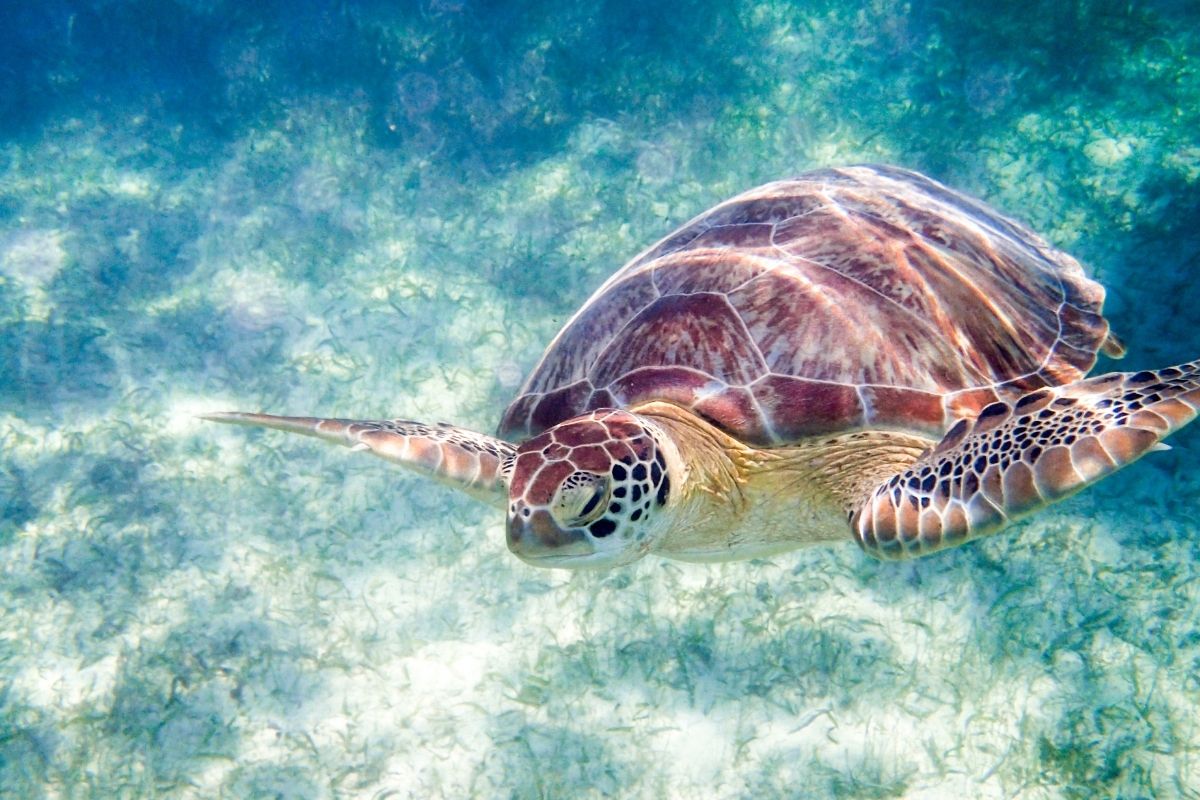Watching a turtle swimming around, you would probably never imagine that this aquatic or semi-aquatic creature could drown.
However, you might be surprised to hear that, under a specific set of circumstances, it is actually possible for turtles to drown.
If you’re a turtle owner yourself, this is understandably a scary thought, but try not to panic.

By taking good care of your turtle, maintaining an optimal turtle enclosure, and knowing the signs of drowning in turtles, you can greatly minimize the chances of this happening.
This guide will cover how turtles breathe, which turtles may drown, and the conditions that lead to turtles drowning.
We will also be discussing what to do if you think your turtle is drowning or has drowned, and answering some of your most frequently asked questions on the subject.
The Turtle’s Respiratory System
Before we can explain how turtles drown, we need to outline how a turtle breathes in the first place.
Because many turtle species spend a lot of time underwater, you would be forgiven for assuming that these fascinating creatures breathe through gills, as fish do.
However, this is not the case. In fact, turtles have lungs, just like us.
The thing to note about a turtle’s lungs is that while they may be much smaller than human lungs, they are also very powerful, which is how a turtle can stay in the water for extended periods of time.
No turtle can stay underwater forever, though, and they will need to come up to the surface to take a breath after about 15 minutes to half an hour, depending on the species.
Can A Turtle Breathe In Water?
The above explanation of the average turtle’s respiratory system and requirements leads us to the question, can a turtle breathe in water?
In a way, yes, turtles can breathe in the water, but the process does not resemble the act that you and I might identify as breathing, and it’s not the same as how a fish breathes underwater, either.
Whereas fish can absorb oxygen from the water through their gills, turtles do not have gills, so this is not possible for them.
What they can do, however, is absorb oxygen in the water through the scales on their bodies.
This absorption isn’t enough to allow them to stay in the water indefinitely, but it’s part of the reason why they can stay submerged for as long as they do.
It is important to note that while you might occasionally see a turtle blowing bubbles through its mouth, this does not mean that the turtle is breathing.
It does, however, mean that oxygen is escaping from the turtle’s body, and this is a common sign of respiratory infection in turtles.
Therefore, if you notice that your pet turtle is blowing bubbles in the water, don’t just assume that it is breathing – take it to a vet at the earliest opportunity.
Do Turtles Sleep Underwater?
Given that turtles need to come to the surface of the water regularly in order to breathe properly, you might be wondering whether turtles can sleep underwater.
It’s true that turtles can and frequently do sleep underwater.
In fact, if you have a pet turtle at home, you have probably seen it taking a nap while submerged, and you might have noticed that they do this for almost an hour at times.
Based on the information provided above where we have stated that most turtles can only hold their breath for a maximum of 30 minutes. This might be confusing.
And if you have seen your turtle submerged for longer than half an hour, you might begin to worry that they have drowned. However, you shouldn’t panic in this situation.
Turtles are able to sleep underwater for up to one hour because, as we mentioned previously, they can absorb small quantities of oxygen through their scales.
When swimming around, this oxygen would not be enough to sustain them for long because they would be using up energy, which requires a higher oxygen supply.
However, when your turtle is sleeping, they are not using very much energy, so the minimal oxygen absorbed through their scales is enough to keep them healthy for longer.
What About Hibernation?
Turtles are able to hibernate under the water in roughly the same way as they are able to sleep while completely submerged: you guessed it, by absorbing oxygen through their skin!
Of course, hibernation lasts much longer than the average sleep.
Wild turtles often submerge themselves under the water or in the mud at the bottom of bodies of water during the winter months so that they can conserve body heat while staying hidden from predators above ground.
While hibernating (also known as brumating), turtles use even less energy than they do while sleeping because their bodies partially shut down except for absolutely essential functions.
So, they are able to survive on the very small oxygen quantities absorbed through their scales until warmer temperatures come around again.
Can Turtles Drown?

Taking into consideration all of the above information, can turtles drown?
The answer is yes, turtles can drown. It might not happen particularly often, but under the wrong circumstances, they can find themselves in a situation where they are unable to get out of the water before they run out of oxygen.
This usually happens in one of two ways:
- The turtle does not have an accessible basking spot. While a turtle can still reach the surface of the water and take a breath without having to use a basking spot, turtles don’t have an unlimited supply of energy. Eventually, without a place to bask and rest, the turtle will get tired and won’t be able to take in enough oxygen to keep swimming. This ultimately leads to drowning.
- The turtle gets stuck underwater. This might happen if the turtle is flipped upside down and can’t turn itself over again. In the case of wild turtles, they could get trapped in a net. Even pet turtles in aquariums might get stuck if a structure in their environment, such as a rock, tips over, and they get trapped underneath. Regardless of how it happens, a turtle that is unable to make it to the surface of the water will eventually drown due to a lack of oxygen.
Do Red-Eared Sliders Drown?
Red-eared sliders are some of the most commonly owned pet turtles, so many owners are specifically concerned about whether this turtle species can drown.
Like any turtle, a red-eared slider may drown if they are deprived of oxygen.
However, the incidence of red-eared slider turtles drowning is very rare because these turtles are fully aquatic, meaning that they spend basically their entire lives in the water.
With that being said, like all turtles, red-eared sliders need to breathe air in order to maintain their oxygen levels, so if something prevents them from getting to the surface of the water, they will drown.
This is why it is so important to keep an eye on your turtles if you keep these animals as pets.
Obviously, you can’t watch your turtles 24/7, but you should check on them throughout the day to make sure that they have not flipped upside down.
Similarly, you should make sure that larger structures in your aquarium are as stable as possible to minimize the risk of them falling and trapping your turtles underneath.
Could A Sea Turtle Drown?
Sea turtles are able to remain underwater for hours at a time, so the chances of one of these turtles drowning are relatively slim. It is not, however, impossible.
As we mentioned earlier, one of the main causes of wild turtles, such as green sea turtles or loggerhead sea turtles, drowning is getting caught in a fishing net.
Once a turtle is trapped in a net, it obviously can’t get to the surface of the water to draw breath, and eventually, its oxygen supply will run out.
Can Box Turtles Drown?
Box turtles are some of the most likely turtles to accidentally drown. Box turtles include species such as mud turtles and Reeve’s turtles.
These turtles are more of a drowning risk than other species because they get tired more quickly.
So, if they can’t immediately access a basking spot or get to the surface of the water fast enough, they could run out of oxygen and drown.
If you own one of these turtles, you should be prepared to check in on it more frequently and ensure that you have an easily-accessible basking dock in their enclosure at all times.
Do Baby Turtles Drown?
Baby turtles are adorable, so it’s hardly surprising that so many people want a baby turtle as a pet. However, owners should be aware that baby turtles are more likely to drown than adults.
The reason why baby turtles will succumb to drowning more than fully-grown turtles is simply that their bodies are weaker, and they also have less experience with essential skills like climbing and swimming.
Baby turtles, for example, are more likely to struggle climbing up onto their basking dock. If nobody notices and helps them, baby turtles can eventually drown as a result of exhaustion and oxygen deprivation.
Do Turtles Drown In Their Sleep?
It is understandable that owners might worry about their pet turtles drowning in their sleep. After all, if a turtle is asleep, how does it know if its oxygen supply is low?
Luckily, turtles are actually intelligent beings and their bodies subconsciously know when they need more oxygen.
If a turtle needs to breathe while it is sleeping, its body will normally naturally make its way to the water’s surface so that it can take a breath. Some turtles even sleep just under the surface of the water to make this process easier.
How To Help A Drowning Turtle
If you think that your turtle is in the process of drowning, you will need to act quickly to save its life. However, you shouldn’t spring into action so fast that you lose your cool and do something potentially dangerous.
In the event that you are faced with a drowning turtle, YOU SHOULD NEVER:
- Attempt to give the turtle mouth-to-mouth resuscitation. Remember, turtles have tiny lungs, and while those lungs are powerful, they are not accustomed to the quantity and strength of the average human’s breath. Breathing into your turtle’s mouth or nose could easily damage its organs and will do the opposite of helping it. In the same vein, you should absolutely not attempt to insert a straw or similar device into any part of your turtle’s body as a kind of oxygen tube. This is, again, likely to cause a lot of damage.
- Flip the turtle onto its back . Some well-meaning people turn turtles onto their backs in an effort to administer CPR when they think the turtle is drowning. While this makes sense from a human perspective, lying on its back is an unnatural position for a turtle. In fact, if the turtle is still conscious, being turned over can put it into a state of shock and stress which could lead to a heart attack or make its breathing difficulties worse. Additionally, if you were planning to push on the turtle’s chest to get it breathing, know that this is also a very bad idea. Turtle CPR is performed differently from human CPR and pressing on your turtle’s chest or abdomen can really hurt them.
Instead, if you suspect that your turtle is drowning YOU SHOULD:
- Remain calm and lift the turtle from the water in a vertical position, head down.
- Hold the turtle’s head with your fingers behind its ears and gently stretch out its neck. You should see water coming out of its mouth when you do this.
- Transfer the turtle to a dry, horizontal surface on its front.
- Gently pull the turtle’s front legs out so that they are outstretched. Then, push the legs in again. More water may exit from the mouth.
- Repeat step 4 with the hind legs.
- Keep pulling and pushing the front and hind legs for several minutes. You should do this until water stops coming out of the turtle’s mouth.
- If your turtle is conscious, rush it to the vet. Although it may be alive, it might have sustained internal trauma, so it needs to be examined.
- If there are no signs of life, the last resort is to hold the turtle firmly but gently in one hand, keeping hold of the head, and move your arm from side to side. This should essentially shake any water out of the turtle’s lungs, but it can be traumatic, so be very careful. Again, if your turtle gains consciousness at this point, you need to get straight to the vet for further treatment.
Frequently Asked Questions
How Can I Tell If My Turtle Is Drowning?
It can be difficult to tell if your turtle is drowning. Obviously, if your turtle is trapped under something and not moving, it’s safe to assume that they are either drowning or have already drowned.
However, other signs of a turtle drowning include a lack of reflexes, such as not responding when tapped on its shell.
Your turtle should tuck its legs inside its shell if you tap it on the leg or behind the ear. This is a natural reflex to defend itself against predators, so if there is no response, your turtle is either dead or in serious trouble.
Is My Turtle Dead Or Hibernating?
You might struggle to tell if your turtle has passed away or if it’s just brumating. However, dead turtles will often have loose, saggy skin.
A turtle that has died may also have sunken eyes, and limp limbs, and might smell bad, none of which should be the case with a turtle in hibernation.
Can A Turtle Freeze To Death?
A lack of oxygen isn’t the only way your turtle’s aquatic environment can harm it. If you let the water get too cold, your turtle can actually freeze to death.
This is why it’s so important to have a thermometer in your turtle’s tank to monitor the temperature at all times. Specific temperature requirements will vary according to species.
Conclusion
Contrary to popular belief, turtles can drown for several reasons. Usually, turtles drown because they can’t climb out of the water, either due to exhaustion or being trapped underwater.
If you see a turtle that seems to be drowning, you can attempt to revive it by gently extending its neck and pulling softly on its front and hind legs for a few minutes.
However, even if you do manage to revive your turtle, you’ll need to go to the vet straight away because the turtle will need specialist care after oxygen deprivation.
